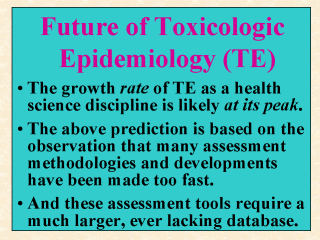In closing this
lecture as well as this series, it is important to note that despite the variety of
educational and career opportunities in exposure or risk assessment, the growth rate
of toxicologic epidemiology is likely already at its peak. This prediction is based
on the observation that many assessment methodologies and developments have been made in
recent years, only to the point that they have become a burden rather than tools in
regulating health risk.For example, while analytical methods now allow the detection of
chemicals easily down to parts per billion or even per trillion, probabilistic analysis
and physiologically-based pharmacokinetic modeling for exposure assessment nowadays are
well received at least in concept (see Lecture 3).
Although these analytical and modeling techniques theoretically yield more accurate and
precise dose estimations, they rely on a much larger, ever lacking database. Their
implementations also require both the proper training of the regulatory scientists and,
worse yet, the adequate support of the regulatory administrators who may not even have a
course in statistics, probability, or pharmacokinetics.
Through regulations and laws, politics has its way that regulatory agencies always bear
a huge financial burden of performing risk assessments. For example, for a nominal
registration fee from a pesticide registrant, a regulatory agency could spend thousands of
person-hours to reach what might still not be a final regulatory decision. True that there
is tax levied on pesticides sold in the market, this tax revenue does not get spent
directly on the risk assessment for any pesticide, whose (ongoing) registration could even
be denied.
